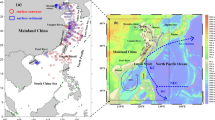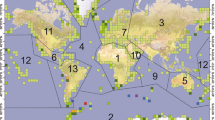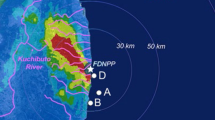Abstract
IN the northern temperate zones, fallout of long lived radionuclides, including caesium-137, varies seasonally, with a maximum during May–June and a minimum during November–December1. The concentration of caesium-137 in caribou flesh and in Alaskan Eskimos shows a similar seasonality2. Because of its half life of 30 yr and the huge stratospheric reservoir of radioactive debris, the amount of caesium-137 on the surface of the Earth is still increasing, despite the moratorium on atmospheric testing3. Although caesium is not a biologically important trace element, chemically it resembles potassium, which is the principal cation of cytoplasm. The bioaccumulation of caesium has therefore aroused considerable interest4,5. Whereas the concentration of caesium in marine organisms is usually about three to thirty times higher than in the surrounding water, the concentration for similar organisms in fresh water may be higher by a factor of 100–1,000 (ref. 5). In laboratory experiments with isopods and snails from brackish water, Bryan6 showed that the biological concentrations of caesium and potassium were directly related and that the concentration factors of both elements were inversely related to the salinity of the water. In the field study reported here, a bivalve mollusc, Rangia cuneata Gray, was collected from six stations in the Trent–Neuse estuary in eastern North Carolina (Fig. 1), and the amount of caesium-137 in the soft tissues was measured periodically for 18 months.
This is a preview of subscription content, access via your institution
Access options
Subscribe to this journal
Receive 51 print issues and online access
$199.00 per year
only $3.90 per issue
Buy this article
- Purchase on SpringerLink
- Instant access to full article PDF
Prices may be subject to local taxes which are calculated during checkout
Similar content being viewed by others
References
Parker, R. P., and Crookall, J. O., Nature, 190, 574 (1961).
Hanson, W. C., and Palmer, H. E., Health Phys., 11, 1401 (1965).
Rep. UN Sci. Comm. Effects Atom. Radiat., Gen. Assem., Seventeenth Sess., suppl. 16(A/5216), 260 (New York, 1962).
Davis, J. J., in Radioecology (edit. by Schultz, V., and Klement, jun., A. W.), 539 (Reinhold, New York, Amer. Inst. Biol. Sci., Washington, D.C., 1963).
Polikarpov, G. G., Radioecology of Aquatic Organisms, 61 (Reinhold, New York, 1966).
Bryan, G. W., J. Mar. Biol. Assoc. U.K., 43, 541 (1963); and in Nuclear Detonations and Marine Radioactivity, 85 (Norwegian Defence Research Establishment, Kjeller, Norway, 1963).
Schelske, C. L., Amer. Biol. Teach., 28, 373 (1966).
Wolfe, D. A., and Schelske, C. L., Proc. Second. Nat. Symp. Radioecol., Ann Arbor, Mich., May 15–17, 1967 (in the press).
Bryan, G. W., J. Mar. Biol. Assoc. UK, 41, 551 (1961).
Author information
Authors and Affiliations
Rights and permissions
About this article
Cite this article
WOLFE, D. Seasonal Variation of Caesium-137 from Fallout in a Clam, Rangia cuneata Gray. Nature 215, 1270–1271 (1967). https://doi.org/10.1038/2151270a0
Received:
Issue Date:
DOI: https://doi.org/10.1038/2151270a0
Comments
By submitting a comment you agree to abide by our Terms and Community Guidelines. If you find something abusive or that does not comply with our terms or guidelines please flag it as inappropriate.



